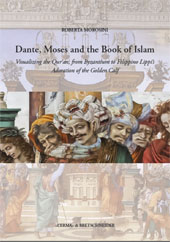Dante, Moses and the Book of Islam : visualizing the Qurʼan, from Byzantium to Filippino Lippi's Adoration of the golden calf
412 p. : ill. (some col.)
Includes bibliographical references.
What does a flying bull with a half moon on its belly in Filippino Lippi's 1502 painting, the Adoration of the Golden Calf, have in common with Muhammad, as a character of Dante's Comedy? This is the question that Roberta Morosini tries to answer by following the journey of a legend traveling in the Oriental Mediterranean. She argues that what Lippis's painting and Dante's Muhammad have in common is a legend of a celestial delivery of the bull law, the Qur'an and Moses's Tablets of the Law. Just as Moses received the Tablets of the Law from God on Mount Sinai, the Qur'an, written according to Thomas Aquinas by mixing fables and a rippled Bible, is carried by the bull on its horns.
Taking us from Medieval Christian Byzantium to the depictions of Muhammad and Averroës in the iconographic tradition, to the Rome of Oliviero Carafa in the events following the Fall of Constantinople in 1453 through Dante's Comedy, the real protagonists of Dante, Moses and the Book of Islam, a story narrated through texts and images, are the Book and the Mediterranean as spaces of transmission of knowledge. Morosini provides a ground breaking reading of Filippino's Adoration of the Golden Calf as an ancient scene of anti-Islam propaganda, while shedding new light on Dante's construction of the cultural other, on his spaces of otherness, and on the importance the poet gives to books that bring unity and give form to what lacks it, like his book, the Comedy. [Publisher's text]
Original title: Dante, il profeta e il libro.
First publ. 2018 in Italian, now revised in English.
Dante Alighieri (1265-1321); Filippino Lippi (-1504).
-
Informationen


